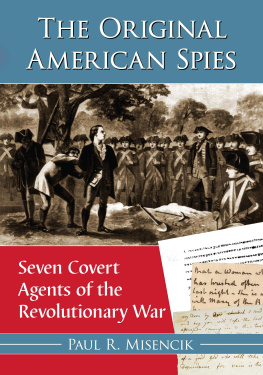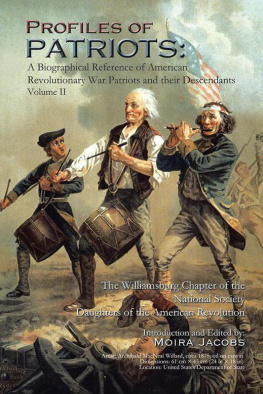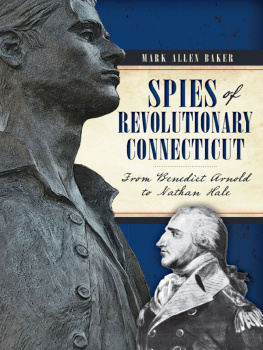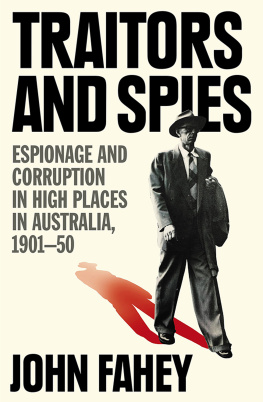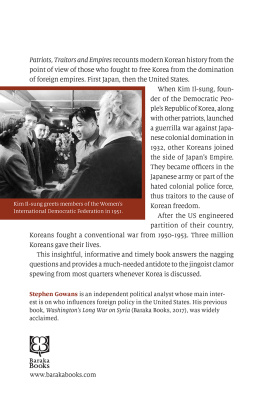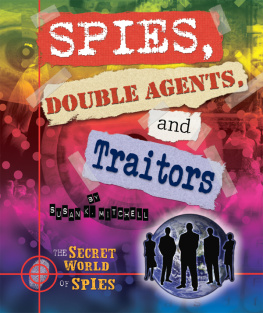Kenneth A. Daigler - Spies, Patriots, and Traitors: American Intelligence in the Revolutionary War
Here you can read online Kenneth A. Daigler - Spies, Patriots, and Traitors: American Intelligence in the Revolutionary War full text of the book (entire story) in english for free. Download pdf and epub, get meaning, cover and reviews about this ebook. year: 2014, publisher: Georgetown University Press, genre: Politics. Description of the work, (preface) as well as reviews are available. Best literature library LitArk.com created for fans of good reading and offers a wide selection of genres:
Romance novel
Science fiction
Adventure
Detective
Science
History
Home and family
Prose
Art
Politics
Computer
Non-fiction
Religion
Business
Children
Humor
Choose a favorite category and find really read worthwhile books. Enjoy immersion in the world of imagination, feel the emotions of the characters or learn something new for yourself, make an fascinating discovery.

- Book:Spies, Patriots, and Traitors: American Intelligence in the Revolutionary War
- Author:
- Publisher:Georgetown University Press
- Genre:
- Year:2014
- Rating:5 / 5
- Favourites:Add to favourites
- Your mark:
- 100
- 1
- 2
- 3
- 4
- 5
Spies, Patriots, and Traitors: American Intelligence in the Revolutionary War: summary, description and annotation
We offer to read an annotation, description, summary or preface (depends on what the author of the book "Spies, Patriots, and Traitors: American Intelligence in the Revolutionary War" wrote himself). If you haven't found the necessary information about the book — write in the comments, we will try to find it.
Kenneth A. Daigler: author's other books
Who wrote Spies, Patriots, and Traitors: American Intelligence in the Revolutionary War? Find out the surname, the name of the author of the book and a list of all author's works by series.
Spies, Patriots, and Traitors: American Intelligence in the Revolutionary War — read online for free the complete book (whole text) full work
Below is the text of the book, divided by pages. System saving the place of the last page read, allows you to conveniently read the book "Spies, Patriots, and Traitors: American Intelligence in the Revolutionary War" online for free, without having to search again every time where you left off. Put a bookmark, and you can go to the page where you finished reading at any time.
Font size:
Interval:
Bookmark:
SPIES, PATRIOTS, AND TRAITORS
American Intelligence in the Revolutionary War
KENNETH A. DAIGLER

2014 Georgetown University Press. All rights reserved. No part of this
book may be reproduced or utilized in any form or by any means, electronic
or mechanical, including photocopying and recording, or by any information
storage-and-retrieval system, without permission in writing from the publisher.
Library of Congress Cataloging-in-Publication Data
Daigler, Kenneth A.
Spies, patriots, and traitors : American intelligence in the Revolutionary War / Kenneth A. Daigler.
pages cm
Includes bioliographical references and index.
ISBN 978-1-62616-050-7 (hardcover : alk. paper)
1. United StatesHistoryRevolution, 17751783Secret service.
2. United StatesHistoryRevolution, 17751783Military intelligence.
3. Military intelligenceUnited StatesHistory18th century.
4. EspionageUnited StatesHistory18th century. 5. SpiesUnited StatesHistory18th century. I. Title.
E279.D35 2014
973.385dc23
2013026131
 This book is printed on acid-free paper meeting the requirements of the American National Standard for Permanence in Paper for Printed Library Materials.
This book is printed on acid-free paper meeting the requirements of the American National Standard for Permanence in Paper for Printed Library Materials.
15 14 9 8 7 6 5 4 3 2 First printing
Printed in the United States of America
To Zach and Quinn,
in the hope that you will read history and learn from it.
Completion of a study this broad would have been impossible without the assistance of researchers and librarians at numerous facilities across the country. I was constantly amazed at the interest and initiative taken by these people, including at local historical societies where volunteers handled my research inquiries. Noting all these facilities and organizations would involve several additional pages, so I shall name only a few of the most heavily involved as representational of the rest: the National Archives, the Library of Congress, the Massachusetts Historical Society, the New York Historical Society, the Rhode Island Historical Society, the Central Intelligence Agencys Historical Collection, the Fred W. Smith National Library for the Study of George Washington at Mount Vernon, the Boston Public Library, the Minuteman Library Network (especially the libraries in Needham and Wellesley, Massachusetts), the District of Columbia Public Library, the Minute Man National Historic Park, and the National Park Service.
There were also several friends who assisted by reviewing the text and providing suggestions to improve its content and flow: Margaret Martin, Carol Herwig, and Bob Lavery. Two others, both authors themselves, provided support by their encouragement and knowledge of manuscript creation: retired US ambassador Edward Marks and Bob Stephan. Special thanks for encouragement and support is also due Donald Jacobs at Georgetown University Press. Finally, my wife Gerry, who had a strong belief in the value of the book from its inception, deserves special thanks for surviving my occasional emotional outbursts, usually early in the morning when I did much of my writing.
Of course, regardless of the assistance and support of those mentioned above, the content of this book is my responsibility alone.
While I was a senior case officer in the Clandestine Service of the Central Intelligence Agency (CIA), one of my managerial responsibilities during a headquarters assignment was to create a suite of conference rooms for use with foreign intelligence liaison visitors to the headquarters complex. In assessing the requirements for this effort, I learned that many foreign intelligence services, especially those having been in existence for centuries in one form or another, often looked upon the agency as being new to the game. While they recognized our skills in the use of cutting-edge technology and respected our other resources, there seemed to be doubts about our experience level and practical understanding of how intelligence activities were conducted.
Having a graduate degree in history, I was aware that as a country, the United States does have more than two hundred years of intelligence experience, including activities during the era of the American Revolution at home and abroad, with successes in all three of the traditional intelligence disciplines: foreign intelligence collection, counterintelligence, and covert action. I decided to name each of the three separate conference rooms after a Revolutionary War figure who had demonstrated success in one of those disciplines. To educate foreign liaison personnel regarding our history in intelligence, I also authored a pamphlet explaining the reasons for the rooms names and providing a brief description of each of the three individuals intelligence activities. George Washington represented foreign intelligence collection, John Jay represented counterintelligence, and Benjamin Franklin represented covert action.
Copies of this pamphlet, The Founding Fathers of American Intelligence, were provided to our foreign liaison visitors, and the positive impression it conveyed caused the agency to make the pamphlet available to the public on its website. This was in 1999, and it has remained a popular download publication ever since. Its content, though quite general compared to the information in this book, has also been used as source material by authors and educators.
This book expands the objective of that pamphlet to educate the general public on the role intelligence activities played in the American Revolution. Covering the period from 1765 to 1783from the organization of the Sons of Liberty to the British withdrawal from New York Cityit discusses how intelligence techniques, operations, and individuals contributed to the cause of American independence.
Much of the book describes intelligence-collection activities against the British by various American agents during the war. Individual chapters describe intelligence efforts in British-occupied Boston, Philadelphia, and New York, and in areas of Pennsylvania and New Jersey. Particular attention is given to the Culper Ring, the best-documented American intelligence network of the war, which operated in and about New York City. However, the book also provides details of George Washingtons background in intelligence, which started prior to the French and Indian War and gave him the mindset and experience to organize and direct intelligence activities while commander of the Continental Army. Also, in an area of the Revolutionary War not well covered previously from the intelligence perspective, Gen. Nathanael Greenes intelligence activities, especially as commander of the Southern Army, are discussed and analyzed.
Counterintelligence operations, both running and detecting enemy spies, are covered in several chapters, including separate ones devoted to in-depth analysis of the tradecraft, or lack thereof, of the two most famous Revolutionary War spies: Nathan Hale and Benedict Arnold. Another chapter deals with John Jays efforts, at least for a few months, to develop a responsible counterintelligence program above New York City in the Hudson Valley. American counterintelligence failures are noted, with a chapter on how the British successfully penetrated the inner circles of the American Commission in Paris, the countrys first diplomatic mission abroad.
Covert action of all types, including paramilitary, political action, and propaganda, is described as conducted in the American colonies and overseas. In this vein the Sons of Libertys activities are reviewed from the perspective of the political-action role the organization played, under the direction of its radical leaders, in moving colonial public opinion from financial independence to political independence from Britain. Various propaganda efforts are highlighted, and paramilitary actions conducted at American direction in Europe and elsewhere are described, including John Paul Joness attack on seaports in England and Scotland.
Next pageFont size:
Interval:
Bookmark:
Similar books «Spies, Patriots, and Traitors: American Intelligence in the Revolutionary War»
Look at similar books to Spies, Patriots, and Traitors: American Intelligence in the Revolutionary War. We have selected literature similar in name and meaning in the hope of providing readers with more options to find new, interesting, not yet read works.
Discussion, reviews of the book Spies, Patriots, and Traitors: American Intelligence in the Revolutionary War and just readers' own opinions. Leave your comments, write what you think about the work, its meaning or the main characters. Specify what exactly you liked and what you didn't like, and why you think so.

